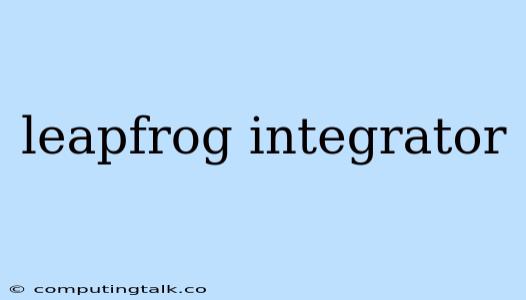The Power of Leapfrog Integrators: Bridging the Gap in Numerical Solutions
The world of numerical solutions is filled with complex problems that require sophisticated tools to tackle. One such tool is the leapfrog integrator, a numerical method for solving ordinary differential equations (ODEs) that has gained significant attention for its unique approach and potential to deliver highly accurate results.
What is a Leapfrog Integrator?
At its core, a leapfrog integrator is a second-order numerical integration method that operates by "leapfrogging" over time steps to achieve a specific accuracy level. Unlike other methods, the leapfrog integrator doesn't directly calculate the value of the variable at the current time step (t). Instead, it uses the values from previous time steps (t-1 and t-2) to determine the value at the next time step (t+1).
How Does the Leapfrog Integrator Work?
Imagine a ball bouncing on a trampoline. To simulate this motion, you'd need to understand its position and velocity over time. The leapfrog integrator uses a technique called the "Verlet scheme" to solve this problem. It involves two steps:
-
Predicting the position: Using the velocity at the previous time step, the leapfrog integrator predicts the position at the next time step.
-
Updating the velocity: Based on the predicted position, the leapfrog integrator updates the velocity at the next time step.
This process is repeated iteratively, allowing the leapfrog integrator to calculate the trajectory of the ball with high accuracy.
Why Use a Leapfrog Integrator?
Several advantages make the leapfrog integrator a valuable tool for numerical solutions:
-
Second-Order Accuracy: The leapfrog integrator offers a relatively high level of accuracy, making it suitable for problems requiring precise solutions.
-
Time-Reversibility: One of the key features of the leapfrog integrator is its time-reversibility. This means the same solution is obtained regardless of whether time is moving forward or backward. This property is crucial for simulating systems with energy conservation, such as planetary motion.
-
Symplectic Nature: The leapfrog integrator is symplectic, meaning it preserves the phase space volume of the system. This property ensures that the numerical solution accurately reflects the behavior of the physical system.
-
Computational Efficiency: Compared to other methods, the leapfrog integrator can be computationally efficient, especially for long-term simulations.
Potential Drawbacks of the Leapfrog Integrator
Despite its advantages, the leapfrog integrator also has some drawbacks:
-
Stability Issues: The leapfrog integrator can become unstable for certain types of problems, particularly those with rapid oscillations or high stiffness.
-
Difficulty in Handling Discontinuities: Implementing a leapfrog integrator for systems with discontinuities, such as collisions, can be challenging and require careful adjustments.
Applications of the Leapfrog Integrator
The leapfrog integrator finds applications in various scientific fields, including:
-
Physics: Simulating planetary orbits, fluid dynamics, and molecular dynamics.
-
Astronomy: Modeling star clusters and galactic interactions.
-
Chemistry: Studying chemical reactions and molecular simulations.
-
Biology: Analyzing protein folding and cell movement.
Conclusion
The leapfrog integrator is a powerful tool for numerical solutions, offering high accuracy, time-reversibility, and computational efficiency. While certain limitations exist, its advantages make it a valuable asset for tackling complex problems in various scientific disciplines. Understanding its capabilities and limitations is crucial for choosing the right numerical method for your specific application.
